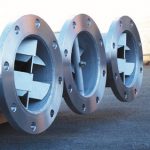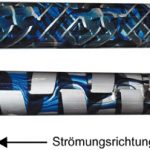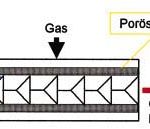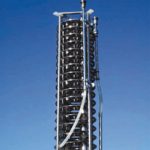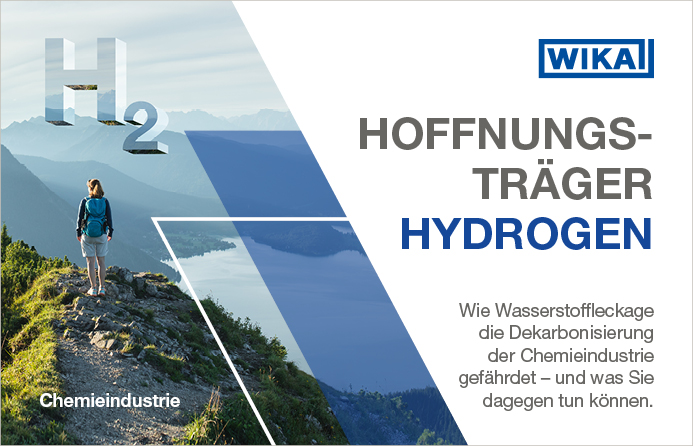Fluitec AG, a firm based in the Swiss town of Winterthur, develops and builds static mixers. With a view to expanding its market position, it recently began to offer complete, small-scale mixing plants as well. cav spoke with Alain Georg, the company’s Managing Director, and Martin B. Däscher of Zürcher Hochschule Winterthur.
The principle of static mixers is simple: exactly-fitting mixing elements are installed inside a tube. The gaseous or liquid media that must be mixed are fed either by means of pumps or under pressure into the tube, where they flow through the static mixing elements. Laminar or turbulent flows, which are what actually effect the mixing process, are produced according to the viscosity of the fluids.
Static mixers and their advantages
Alain Georg has been developing and manufacturing static mixers in his company for more than five years now together with other young engineers and students. In Georg’s opinion, the advantages of these mixers as compared with dynamic mixing systems are self-evident: static mixers are generally cheaper to purchase and consume significantly less energy. Since these machines have no moving parts, they are also characterised by a long service life.
Another important benefit is that they take up much less space while achieving the same throughput. As Georg explains, “A company was planning to change its production over to static mixers. Up until then, they had been using 25 large agitators. They were able to replace these with a single static mixer, with a length of 1 m and a diameter of 100 mm, without any deterioration in mixing performance.”
Static mixers can be employed efficiently in all situations where large quantities of substances have to be treated continuously. Owing to their complex starting phase, these machines are of only limited suitability for batchwise mixing, on the other hand.
Georg emphasises that he has no standard solutions for the static mixers. His firm has meanwhile developed between 300 and 400 different static mixer models for a variety of applications. They differ with regard not only to their dimensions and geometries, but also to the materials with which they are made. These range from PTFE, PVC and polypropylene through various qualities of steel, titanium and tantalum to glass and ceramic. The extreme diversity of Fluitec mixers allows them to be used in all kinds of industries, for instance in chemicals and petrochemicals, food processing, pharmaceuticals, biotechnology, plastics processing and waste water treatment.
Rugged CSE mixers
The first static mixers to be developed, built and marketed by Fluitec were those in the CSE series (Fig. 2). These rugged, short mixing elements, that were originally manufactured from cast iron, are especially suitable for liquids with a low-to-medium viscosity. They can however also be used for gassing liquids or for making dispersions, for example with abrasive solids. They are renowned for their excellent stability, even with highly viscous media (Fig. 3).
“The CSE mixers”, explains Georg, “cause a series of layers to form. The media to be mixed, in other words, are arranged very carefully one on top of the other in thin layers. The mixing elements must however be fitted into the tube extremely exactly, in order to prevent surface zones from developing, since these would have an adverse effect on the residence time spectrum.”
The configuration and the packing density of the mixing elements inside the tube is determined by the viscosity of the components to be processed. They need to be packed very tightly for low-viscosity media. In addition, leaving gaps between the individual mixing elements has proved to be an effective measure. This permits intensive vortexing of the components, leading to a very good mixing effect in the gaps.
The practical experience gained with the CSE mixers in industrial applications led to several subsequent developments. These were aimed at improving the residence time spectrum, reducing the pressure loss and optimising the fluidic properties. The mixers are meanwhile also available in different materials.
Highly efficient FSBR mixers
Static mixers are ideal for gassing liquids, for example in waste water treatment or biotechnology. In the majority of cases mixing elements made of porous, sintered metals are used, and gases such as air, oxygen or ozone are introduced through them into the liquid medium as it flows past. One drawback of this technology is that it is difficult to control the size of the gas bubbles that are produced in the process.
This functional principle has been reversed by Fluitec (Fig. 4). As Georg explains, “The tube used for the FSBR mixers is made of sintered metal. The gas is thus introduced via the porous tube surface. The liquid that must be gassed flows through the mixing elements, which have an identical design and geometry to those in the CSE mixers. The resulting turbulent flow detaches the gas bubbles constantly as they form on the wall of the tube. Micro-bubbles with a diameter of 0.5 mm are produced; they ensure that the gas is continuously redispersed.”
The FSBR mixers are equally suitable for use in laboratories and in industrial-scale applications. They can be supplied either for installation in a tube or as reactor inserts. Their efficiency is between three and five times that of conventional-type static mixers – an aspect which is particularly important when expensive gases are involved.
The development and optimisation of the FSBR mixers are also the outcome of successful collaboration with Zürcher Hochschule Winterthur as well as the financial incentives offered by the Swiss government to young, innovative firms. Martin B. Däscher, in the meantime a member of the academic staff in the Department of Chemistry and Biotechnology at this college of higher education in Winterthur, originally came into contact with the FSBR gassing system while still a student. He is still working in the field today within the framework of a government-sponsored project. “The Swiss government”, says Däscher, “provides financial support for our project. The preconditions are that the project should stand a good chance of market success and that a small or medium-sized company should be behind it. This company must participate with finan-cial resources, materials, equipment, etc. to the same amount as the government. In this particular case, Novartis also contributes 10% towards the costs of the FSBR gassing system.” Däscher researches into mixing and fluidic problems encountered with FSBR mixers, with the aim of further optimising the system. He develops potential models at his college and then tries them out in practice on a test bed constructed by Fluitec specially for this purpose. The tests with the new plant are conducted actually at the college. Däscher is thus able to take advantage of the institution’s expensive analysis equipment as well as its personnel.
Bubble-free gassing with the air-trap reactor
A multitude of small gas bubbles are produced when a liquid is gassed with the FSBR mixer. They may cause severe foaming if the medium contains tensides. In addition, there is a risk with biotechnical applica-tions that the mechanical energy of the rising – and subsequently bursting – gas bubbles will destroy the cells. These drawbacks can be avoided with the air-trap reactor, which facilitates bubble-free gassing (Fig. 5).
“When we developed the air trap”, explains Georg, “we based it on the principle of the diving bell. This bell, filled with air, used to be the method employed to supply divers with respiratory air underwater. The air-trap reactor consists of several diving-bell stages, to which gas is applied. The individual bells are connected together by means of a valve system, which allows the gas to circulate. Bubble-free gassing is achieved thanks to the solution equilibrium that is produced in every diving bell at the boundary layer between liquid and gas.”
The air-trap reactors are remarkable for their outstanding efficiency as compared with other techniques, such as bubble-free gassing using silicone hoses. The circulation of the gas between the individual bells ensures almost 100% utilisation. (le)
Further information
about the CME mixer cpp-258
about the FSBR mixer cpp-259
about the air-trap reactor cpp-260
Breakthrough with plasticine and polystyrene
Fluitec was founded by Georg as a one-man firm more than five years ago, in March 1994, with a starting capital of 50000 SFr. His living room was transformed into a drawing office and his garage into a laboratory, where he tested models of the future CSE mixers he had built with polystyrene and plasticine. It was through John Hopfgartner, a friend, that he established his initial contacts with Zürcher Hochschule Winterthur; they proved to be an important foundation for his firm’s success and he still maintains them to this day.
Just one year after setting up the company, Georg received the Siska Prize awarded to successful young businessmen by a major Winterthur property firm. The prize is worth a total of 155000 SFr, including 100000 SFr in the form of an interest-free loan. “The Siska Prize”, recalls Georg, “first of all made the name Fluitec known to the general public. Secondly, it brought in money that we invested in a production plant of our own, personnel and marketing for our products. It also enabled us to turn the firm into a public limited company.”
1998 saw the firm’s merger with the German Schwing Fluid Technik AG. This company, which is likewise active in the field of static mixing technology, now handles all sales of Fluitec products worldwide in the area of plastics processing. “The merger with Schwing”, explains Georg, “has improved Fluitec’s capacity utilisation and given us greater financial security. We have also gained easier access to international markets thanks to the global operations of our German partner.”
Last year the firm achieved a turnover of 1 million SFr. Although 1999 began with a sharp fall in incoming orders, Georg is in no doubt of his ability to boost sales to 1.7 million SFr in the course of the present financial year.
Unsere Whitepaper-Empfehlung
Wasserstoff gilt als Schlüssel für die Dekarbonisierung der Chemieindustrie. Doch die Nutzung des vermeintlichen Hoffnungsträgers Hydrogen birgt auch Gefahren und stellt die Branche vor neue Herausforderungen, die das gratis Whitepaper „H2 wie Hoffnungsträger?“ näher für Sie…
Teilen:




